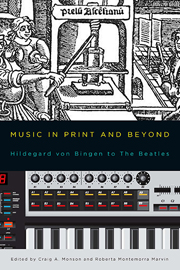Book contents
- Frontmatter
- Dedication
- Contents
- Acknowledgments
- Introduction
- 1 Robert Granjon and Music during the Golden Age of Typography
- 2 Publishing Music Theory in Early Cinquecento Venice and Bologna: Friends and Foes
- 3 Preaching to the Choir: Arts of Persuasion in the Converts of Italy
- 4 Music Distribution in London during Handel's Lifetime: Manuscript Copies versus Prints
- 5 Beethoven's Miniatures
- 6 “The Beautiful and the Ugly”: Travel Literature, Racial Theory, and a Schumann Song
- 7 Verdi's “Music of the Future”
- 8 The Suspended Voice of Amália Rodrigues
- 9 More than Mostly Mozart: Teddy Wilson's “China Boy”
- 10 Wanted Dead and Alive: Historical Performance Practice and Electro-Acoustic Music from IRCAM to Abbey Road
- 11 Lowinsky's Secrets
- 12 The Unknown Hildegard: Editing, Performance, and Reception (An Ordo Virtutum in Five Acts)
- List of Contributors
- Index
7 - Verdi's “Music of the Future”
Published online by Cambridge University Press: 05 March 2014
- Frontmatter
- Dedication
- Contents
- Acknowledgments
- Introduction
- 1 Robert Granjon and Music during the Golden Age of Typography
- 2 Publishing Music Theory in Early Cinquecento Venice and Bologna: Friends and Foes
- 3 Preaching to the Choir: Arts of Persuasion in the Converts of Italy
- 4 Music Distribution in London during Handel's Lifetime: Manuscript Copies versus Prints
- 5 Beethoven's Miniatures
- 6 “The Beautiful and the Ugly”: Travel Literature, Racial Theory, and a Schumann Song
- 7 Verdi's “Music of the Future”
- 8 The Suspended Voice of Amália Rodrigues
- 9 More than Mostly Mozart: Teddy Wilson's “China Boy”
- 10 Wanted Dead and Alive: Historical Performance Practice and Electro-Acoustic Music from IRCAM to Abbey Road
- 11 Lowinsky's Secrets
- 12 The Unknown Hildegard: Editing, Performance, and Reception (An Ordo Virtutum in Five Acts)
- List of Contributors
- Index
Summary
In late December 1870 Verdi was invited to serve as director of the Naples Conservatory. Although he declined the “honor” for numerous reasons, the invitation provided an opportunity for him to verbalize his ideas on the subject of what and how aspiring Italian composers should be taught. One of his letters on the topic, to the Neapolitan archivist and librarian Francesco Florimo, dated January 5, 1871, was published (with the composer's permission) in Italian journals, thereby making Verdi's thoughts public. The following excerpt conveys the essence of Verdi's position: “I would be proud to occupy that post, where the founders of a school sat: A. Scarlatti, and later [Francesco] Durante and [Leonardo] Leo. It would have made me proud (and at this point it would not have been a step backward) to exercise the students in those serious, rigorous, and, in this instance, renowned studies, of these early fathers. I would have insisted, as it is said, on putting one foot in the past, and the other in the present and in the future, for I am not afraid of the music of the future.” Three essential points emerge here: Verdi's recommendations and cautions to young composers for rigorous study of traditional techniques, his adamance about progress in music requiring a synthesis of past and present, and his asserted willingness to confront new trends, i.e., the “music of the future.”
- Type
- Chapter
- Information
- Music in Print and BeyondHildegard von Bingen to The Beatles, pp. 158 - 179Publisher: Boydell & BrewerPrint publication year: 2013

